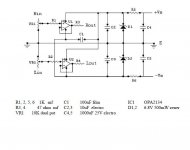I'm currently building this buffer circuit (see attached).
The circuit is generally used with the OPA2134 because it is unity gain stable, but I'd like to try it out with the BUF634 because this IC suits the purpose of a buffer circuit more than the OPA2134. I'll need to ensure that it is OK for two BUF634P mounted on this adapter:
Single-to-dual Op-AMP Adapter - DIP version (p/n 021001)
Will I need to change anything in the circuit or on the adaper to ensure it functions optimally?
FYI, I'm using this power supply:
LC Audio Low Noise DC Regulator - Soundlabs Group
The circuit is generally used with the OPA2134 because it is unity gain stable, but I'd like to try it out with the BUF634 because this IC suits the purpose of a buffer circuit more than the OPA2134. I'll need to ensure that it is OK for two BUF634P mounted on this adapter:
Single-to-dual Op-AMP Adapter - DIP version (p/n 021001)
Will I need to change anything in the circuit or on the adaper to ensure it functions optimally?
FYI, I'm using this power supply:
LC Audio Low Noise DC Regulator - Soundlabs Group
Attachments
Unsure at this stage. I've checked the datasheet:
http://focus.ti.com/lit/ds/symlink/buf634.pdf
But can't see any guiding points re input impedance - what calculations do I need to make?
http://focus.ti.com/lit/ds/symlink/buf634.pdf
But can't see any guiding points re input impedance - what calculations do I need to make?
Check the section INPUT in the datasheet. There you have input impedance, 80 or 8 MOhms depending of selected bandwidth.
The OPA1642 is even better. An open loop buffer is not a good idea and what you also need to calculate how the pot effects the frequency response you have to know not only the input impedance but also the input capaciatance. Honestly i have not looked into that because i ALWAYS use the BUF inside a feeback loop.
8pF capacitance is not a problem with 10k source.
The distortion is not usefully specified. The differential gain and phase could be met with some serious crossover distortion
The distortion is not usefully specified. The differential gain and phase could be met with some serious crossover distortion
Not at all. How do you mean?I take that means it will be a complete mismatch - better to stick with the OPA2134?
Even with 100k input impedance it would have worked so 80 to 800 times more is perfectly OK.
Hello David. I looked it up too and 8pF is not a problem, even with a 100kOhm pot, i agree. The BUF 634 has semy decent open loop performace but it is ot optimsed for that use. It is a diamond buffer and i found other open loop topologies better sounding like the B1 DC buffer or the circuits i have postet on my MPP tread.
The BUF 634 has semy decent open loop performace but it is ot optimsed for that use.
Fwiw many years ago i tried it open loop and within an AD8610 nfb loop. It's presence is clearly audible both in and out of the loop but getting it inside the loop improves its sonic signature a lot. And iirc also reduced the offset.
I know this thread is about the BUF634, but I'm currently building a headphone amp with LME49600 buffers that will allow me to run the buffers open loop with a simple jumper change.
I've read plenty of people saying running them open loop in a headphone amp is a bad idea, but I want to hear the difference for myself. Simulations show 0.08% distortion into a 300 ohm load with a 7Vrms output (160mW).
The circuit has a servo, so offset in open loop mode will be a non-issue.
It's basically this exact same board I previously built, but with the open loop jumper option.
(sorry for the hijack)
I've read plenty of people saying running them open loop in a headphone amp is a bad idea, but I want to hear the difference for myself. Simulations show 0.08% distortion into a 300 ohm load with a 7Vrms output (160mW).
The circuit has a servo, so offset in open loop mode will be a non-issue.
It's basically this exact same board I previously built, but with the open loop jumper option.
(sorry for the hijack)
An externally hosted image should be here but it was not working when we last tested it.
Fwiw many years ago i tried it open loop and within an AD8610 nfb loop. It's presence is clearly audible both in and out of the loop but getting it inside the loop improves its sonic signature a lot. And iirc also reduced the offset.
OK - I'm with you now.
It's the "open-loop" that causes the problem - what is the next best bet for an 8 pin DIP (DIL) IC that is unity gain stable AND performs well out of the loop?
- Status
- Not open for further replies.
- Home
- Source & Line
- Analog Line Level
- BUF634P - pinout
